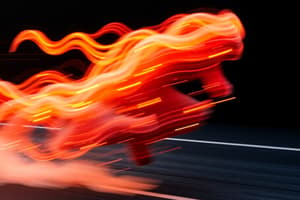Podcast
Questions and Answers
What is essential to describe the position of an object?
What is essential to describe the position of an object?
- The speed of the object
- A specific path
- A reference point called the origin (correct)
- The direction of motion
What is the purpose of an odometer in an automobile?
What is the purpose of an odometer in an automobile?
- To measure the acceleration of the car
- To measure the distance travelled (correct)
- To measure the speed of the car
- To measure the direction of motion
What type of motion is described by an object moving along a straight path?
What type of motion is described by an object moving along a straight path?
- Motion along a curved path
- Random motion
- Motion along a circular path
- Motion along a straight line (correct)
Why do we need to study the motion of objects?
Why do we need to study the motion of objects?
What is the difference between distance and displacement in the context of the Activity 7.3?
What is the difference between distance and displacement in the context of the Activity 7.3?
What is true about an object's motion when its position changes with time?
What is true about an object's motion when its position changes with time?
Why do we not directly perceive the motion of the earth?
Why do we not directly perceive the motion of the earth?
What do the observations of the moving bus and the roadside trees indicate?
What do the observations of the moving bus and the roadside trees indicate?
What type of motion will be discussed later in this chapter?
What type of motion will be discussed later in this chapter?
What is the primary focus of this chapter?
What is the primary focus of this chapter?
Flashcards are hidden until you start studying
Study Notes
Motion in Everyday Life
- Objects in motion are observed in everyday life, such as birds flying, fish swimming, and cars moving.
- Atoms, molecules, planets, stars, and galaxies are all in motion.
- Motion can be perceived directly or inferred through indirect evidence, such as observing the movement of dust and leaves to infer the motion of air.
Relative Motion
- An object can appear to be moving for one person and stationary for another.
- The perception of motion depends on the observer's frame of reference.
Types of Motion
- Motion can be complex and take various forms, such as straight line, circular, rotational, and vibrational motion.
- Some objects may exhibit a combination of these types of motion.
Describing Motion
- To describe the motion of an object, we need to specify a reference point called the origin.
- The location of an object can be described by specifying its position with respect to the reference point.
Motion Along a Straight Line
- The simplest type of motion is motion along a straight line.
- The motion of an object along a straight line can be described by specifying its position at different instants.
- The distance covered by an object and its displacement are two distinct concepts.
Key Concepts
- Distance is the total length of the path traveled by an object.
- Displacement is the shortest distance between the initial and final positions of an object.
- Odometers are devices used to measure the distance traveled by a vehicle.
Studying That Suits You
Use AI to generate personalized quizzes and flashcards to suit your learning preferences.




